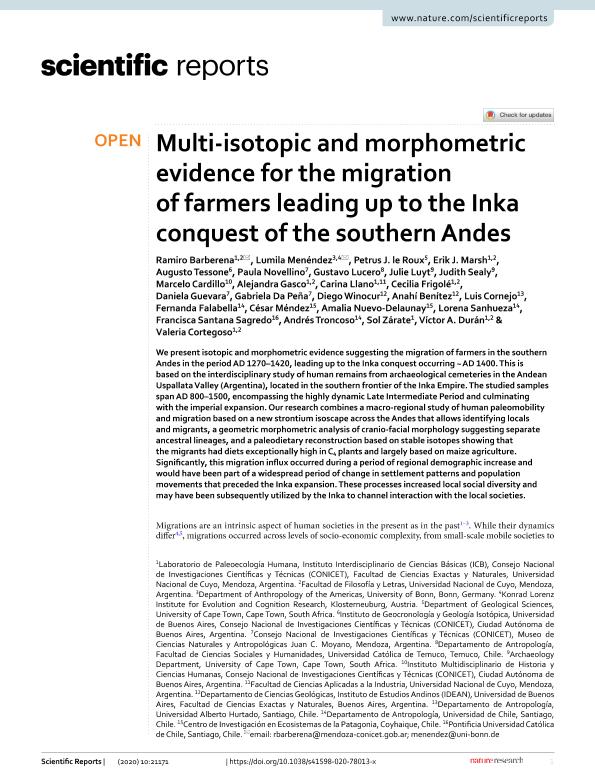Artículo
Multi-isotopic and morphometric evidence for the migration of farmers leading up to the Inka conquest of the southern Andes
Barberena, Ramiro ; Menéndez, Lumila; le Roux, Petrus J.; Marsh, Erik Johnson
; Menéndez, Lumila; le Roux, Petrus J.; Marsh, Erik Johnson ; Tessone, Augusto
; Tessone, Augusto ; Novellino, Paula Silvana
; Novellino, Paula Silvana ; Lucero, Gustavo; Luyt, Julie; Sealy, Judith; Cardillo, Marcelo
; Lucero, Gustavo; Luyt, Julie; Sealy, Judith; Cardillo, Marcelo ; Gasco, Alejandra Valeria
; Gasco, Alejandra Valeria ; Llano, Carina Lourdes
; Llano, Carina Lourdes ; Frigolé, Cecilia Andrea
; Frigolé, Cecilia Andrea ; Guevara, Daniela; Da Peña, Gabriela; Winocur, Diego Alejandro; Benítez, Anahí; Cornejo, Luis; Falabella, Fernanda; Méndez, César; Nuevo Delaunay, Amalia; Sanhueza, Lorena; Santana Sagredo, Francisca; Troncoso, Andrés; Zárate, Sol; Duran, Victor Alberto
; Guevara, Daniela; Da Peña, Gabriela; Winocur, Diego Alejandro; Benítez, Anahí; Cornejo, Luis; Falabella, Fernanda; Méndez, César; Nuevo Delaunay, Amalia; Sanhueza, Lorena; Santana Sagredo, Francisca; Troncoso, Andrés; Zárate, Sol; Duran, Victor Alberto ; Cortegoso, Valeria
; Cortegoso, Valeria
 ; Menéndez, Lumila; le Roux, Petrus J.; Marsh, Erik Johnson
; Menéndez, Lumila; le Roux, Petrus J.; Marsh, Erik Johnson ; Tessone, Augusto
; Tessone, Augusto ; Novellino, Paula Silvana
; Novellino, Paula Silvana ; Lucero, Gustavo; Luyt, Julie; Sealy, Judith; Cardillo, Marcelo
; Lucero, Gustavo; Luyt, Julie; Sealy, Judith; Cardillo, Marcelo ; Gasco, Alejandra Valeria
; Gasco, Alejandra Valeria ; Llano, Carina Lourdes
; Llano, Carina Lourdes ; Frigolé, Cecilia Andrea
; Frigolé, Cecilia Andrea ; Guevara, Daniela; Da Peña, Gabriela; Winocur, Diego Alejandro; Benítez, Anahí; Cornejo, Luis; Falabella, Fernanda; Méndez, César; Nuevo Delaunay, Amalia; Sanhueza, Lorena; Santana Sagredo, Francisca; Troncoso, Andrés; Zárate, Sol; Duran, Victor Alberto
; Guevara, Daniela; Da Peña, Gabriela; Winocur, Diego Alejandro; Benítez, Anahí; Cornejo, Luis; Falabella, Fernanda; Méndez, César; Nuevo Delaunay, Amalia; Sanhueza, Lorena; Santana Sagredo, Francisca; Troncoso, Andrés; Zárate, Sol; Duran, Victor Alberto ; Cortegoso, Valeria
; Cortegoso, Valeria
Fecha de publicación:
12/2020
Editorial:
Nature
Revista:
Scientific Reports
ISSN:
2045-2322
Idioma:
Inglés
Tipo de recurso:
Artículo publicado
Clasificación temática:
Resumen
We present isotopic and morphometric evidence suggesting the migration of farmers in the southern Andes in the period AD 1270–1420, leading up to the Inka conquest occurring ~ AD 1400. This is based on the interdisciplinary study of human remains from archaeological cemeteries in the Andean Uspallata Valley (Argentina), located in the southern frontier of the Inka Empire. The studied samples span AD 800–1500, encompassing the highly dynamic Late Intermediate Period and culminating with the imperial expansion. Our research combines a macro-regional study of human paleomobility and migration based on a new strontium isoscape across the Andes that allows identifying locals and migrants, a geometric morphometric analysis of cranio-facial morphology suggesting separate ancestral lineages, and a paleodietary reconstruction based on stable isotopes showing that the migrants had diets exceptionally high in C4 plants and largely based on maize agriculture. Significantly, this migration influx occurred during a period of regional demographic increase and would have been part of a widespread period of change in settlement patterns and population movements that preceded the Inka expansion. These processes increased local social diversity and may have been subsequently utilized by the Inka to channel interaction with the local societies.
Palabras clave:
MIGRATION OF FARMERS
,
AD 12701420
,
ISOTOPIC STUDIES
,
SOUTHERN ANDES
Archivos asociados
Licencia
Identificadores
Colecciones
Articulos(ICB)
Articulos de INSTITUTO INTERDISCIPLINARIO DE CIENCIAS BASICAS
Articulos de INSTITUTO INTERDISCIPLINARIO DE CIENCIAS BASICAS
Articulos(IDEAN)
Articulos de INSTITUTO DE ESTUDIOS ANDINOS "DON PABLO GROEBER"
Articulos de INSTITUTO DE ESTUDIOS ANDINOS "DON PABLO GROEBER"
Articulos(IMHICIHU)
Articulos de INST.MULTIDISCIP.DE HISTORIA Y CS.HUMANAS
Articulos de INST.MULTIDISCIP.DE HISTORIA Y CS.HUMANAS
Articulos(INGEIS)
Articulos de INST.DE GEOCRONOLOGIA Y GEOLOGIA ISOTOPICA (I)
Articulos de INST.DE GEOCRONOLOGIA Y GEOLOGIA ISOTOPICA (I)
Citación
Barberena, Ramiro; Menéndez, Lumila; le Roux, Petrus J.; Marsh, Erik Johnson; Tessone, Augusto; et al.; Multi-isotopic and morphometric evidence for the migration of farmers leading up to the Inka conquest of the southern Andes; Nature; Scientific Reports; 10; 1; 12-2020; 1-12
Compartir
Altmétricas



